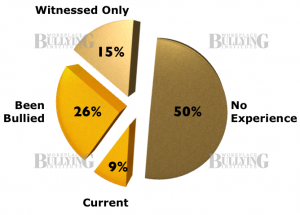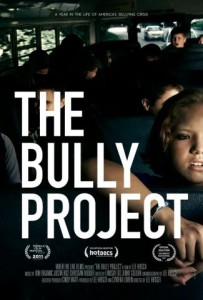June 19th, 2013

The 2010 Workplace Bullying Survey, courtesy Workplace Bullying Institute
“I think adults need to know they’re doing the same thing. It’s not just kids. There are adults that are out there bullying, and they need to be kind.” Ellen DeGeneres
As a supporter of school bullying prevention programs for almost 15 years, I am encouraged. More and more states have passed anti bullying laws, more school systems have begun implementing programs, the reception of the documentary “Bully” has been overwhelming, and we’ve finally collectively decided that the “kids will be kids” excuse isn’t working anymore. As thirty percent of students in the United States are involved in bullying on a regular basis either as a victim, bully or both and over 13 million kids are suffering from bullying, the movement needed to happen, and it needs to continue. Thankfully, as the “Bully” team went through the process of making the documentary, we found fierce advocates. They came from everywhere. Kids, parents, teachers, the media, celebrities, and Congress on both sides of the aisle stepped up and spoke out.
But, where are we when the mirror turns to us big kids? I’ve found less support there, and it doesn’t surprise me. It’s harder to turn the spotlight on ourselves. A Huffington Post piece I did in October, 2012, called “Who Did You Bully today?” http://www.huffingtonpost.com/cindy-waitt/who-did-you-bully-today_b_2006802.html, made the point that until we stopped bullying each other, we won’t see the results we want to see from our kids. I named multiple sectors of adults (including me) who bully, from the home (the first role models kids have, and the most important place to stem violence), to the workplace, to Congress, to cyberspace, and yes, the constant, mind numbing barrage of reality shows. A lot of these big boys and big girls in all of these places continue to not only not be kind, but to be brutal to each other on so many of our adult “playgrounds and school yards”. I’ve written about the link between violence in the home and violence in school, and the data backs it up. But, as the workplace, for us, is similar to our schoolyard, where we interact, socialize, work, play, learn, grow, and spend much of our waking hours, I decided to check into that again and see just how we are doing.
It’s not good. As you can see above, 35% report being bullied at some time in their work life, and another 15% witnessed it. Putting the numbers together, WBI says, with a well place exclamation point, “An astonishing 54 million Americans directly experience it!”. I get the exclamation. That’s abysmal news. The Waitt Institute for Violence Prevention actually co-sponsored the first national survey with WBI and Zogby in 2007, and those results were similar, and disheartening.
“Bully” explores the mental, physical, and emotional toll on the victims and their families. It’s hard to watch Alex being brutalized, and the despair of the Longs and the Smalleys, who suffered the cruelest loss-the suicide of their children. We don’t have a film like that to show damage from the workplace, but it’s there. The late Tim Field, an early advocate of workplace bullying prevention, said, ” Nothing can prepare you for living or working with a sociopathic serial bully. It is the most devastating, draining, misunderstood, and ultimately futile experience imaginable.”.
Here’s a slice of what it looks like, according to WBI. Is this happening to you, or someone in your workplace?
- Verbal abuse
- Offensive conduct/behaviors (including nonverbal) which are threatening, humiliating, or intimidating
- Work interference — sabotage — which prevents work from getting done
- Is driven by perpetrators’ need to control the targeted individual(s).
- Is initiated by bullies who choose their targets, timing, location, and methods.
- Requires consequences for the targeted individual
- Escalates to involve others who side with the bully, either voluntarily or through coercion.
- Undermines legitimate business interests when bullies’ personal agendas take precedence over work itself.
- Is akin to domestic violence at work, where the abuser is on the payroll
- Constant criticism
- Mobbing or targeting by a group
It’s classic bullying, and looking at the list, eerily similar to what can happen to children. The outcome looks similar to what children experience as well. Here are the consequences to our bodies and our minds according to a WBI online survey in 2012. “The top 15 health problems from bullying, ranked from most to least frequent, were:Anticipation of next negative event; Overwhelming anxiety; Sleep disruption (hard to begin/too little); Loss of concentration or memory; Uncontrollable mood swings; States of agitation or anger; Pervasive sadness; Heart palpitations; Insomnia; High blood pressure (hypertension); Obsession over personal circumstances; Intrusive thoughts (flashbacks, nightmares); Loss of affect (flat emotional responses); Depression (diagnosed); Migraine headaches”
It’s real, it’s pervasive, and all of it needs attention, just as we’ve started attending to our kids. I have hopes that the current school age generation may learn early what we adults haven’t. I also have hopes that because of the anti school bullying and violence prevention movement, we can give today’s children the social and emotional tools to recognize bullying in themselves and in others. But, if we continue to treat each other this way, wherever we interact as grown ups, can we continue then to expect more from our kids? Let’s learn to model respect, kindness, and decency. Kids watch us, they listen to us, and we can make a difference. But, let’s look in the mirror first, and go from there .
For more information, visit these sites….
Comments (0)
February 14th, 2013

The original poster.
May 6, 2009
From: alan@waittinstitute.org
To: cindy@waittinstitute.org
Subject: The Bully Project
From that first e-mail nearly four years ago introducing me to what became Lee Hirsch and Cynthia Lowen’s documentary “Bully”, I’ve only sobbed twice. I’ve cried at screenings, cried a time or two when things got frustrating with the process, and cried a bit when my part was finished. But two times, I had those gut wrenching “tear fests” that not only shake your body, but shake your soul along with it. You tend to remember those.
The first time it happened was in La Jolla, California in December of 2009. It was the night before the year-end board meeting of the Waitt Foundation and the Waitt Institute for Violence Prevention. Along with updates on many of our long standing projects, I was presenting a new one. It was called “The Bully Project”, a film about child-to-child bullying. I didn’t have much that was solid. I had a preliminary budget, one of those “shot in the dark” estimates that change during production and post production. I had Lee Hirsch and Cynthia Lowen’s vision and their passion, but they wouldn’t be in the room. I needed something brief and powerful, something that would demonstrate the urgent need for this project.
Lee sent it to me that night. In Lee fashion, he might come right down to the wire, but what he sends is almost always brilliant. What he sent that night was breathtaking. It was a three minute clip of footage he’d gathered from the family of Tyler Long, the 17 year old boy from Georgia, who took his own life less than two months before. Among home made film clips the family supplied of Tyler’s short life, was his father David’s running commentary about the torment Tyler experienced and the heartbreak the family was going through. It was real, it was raw, and it hit me where it hurt the most, as a parent. I think that night I moved from a passionate supporter of an important issue to a mother with a mission.
The meeting the next day was early, and I was first of a long line of presenters that day. I had just wrapped up the yearly summary. Time was running short, but I had one more thing to present to the group, which that day included our investment advisers, attorney, accountants, management staff, and the members of the board. I’ve learned that when you present to this group, it’s a good idea to be clear, concise, and have your numbers in order…particularly the numbers. Most of these people have a business background. I don’t, I’m a social worker. A glance at the clock told me I had about 3 minutes left.
I showed the clip. When it was done, there was a silence, not necessarily a good thing when you’re showing film clips, but I’d had been watching the group intently. The reactions ranged from actual tears to that kind of uncomfortable shifting in the seat that people do when they’re trying not to cry. I hadn’t shown them the budget, the time projections of production and post production, or the ideas that were already forming with a social action campaign. Ted just said to me, “How much do you need?”
The film was the perfect meshing of the right time, right place, right issue as well as the skill and passion of the film makers. But it was more. For me at least that day, in that room, it was watching those people, probably 90%of them parents, reacting as humans caring about their young.
We weren’t the only supporters of the film, we just came in early, as did the brave and forward thinking Sioux City Community School District. We had partners show up, first a few, then.. the many. The next year brought The BeCause Foundation, The Einhorn Family Charitable Trust, and The Fledgling Fund. After that others joined in, and not just the large foundations. There were hundreds, if not thousands of supporters, who knew this film should get finished and get out there to kids, parents, and educators. The film’s purchase in April of 2011 by the powerful and influential Weinstein Company then took us places we never thought we’d go. Harvey Weinstein didn’t have to get behind the film, but he did, and as Lee said, everything he promised came true.
The second time I broke down? It the night in January that Lee and Cynthia accepted the “Stanley Kramer Award” given each year by the Producers Guild of America. I couldn’t be there that night , but Lee kept me posted. In a text message, he sent me this:

It brought on the tears, again. I think that was because I thought that really none of us is alone in this sometimes harsh and uncomfortable world. We do our best work when we do it together. It not only took a village to raise this “child”, it took a nation. Every one who wrote a check, a news story, a tweet, a petition, or a comment in support, and who helped “raise” the film and the project played a role. As David Long says, “Everything starts with one and builds up”. To the “ones” who became the many, thank you.
Comments (0)



